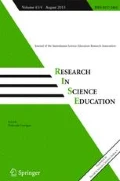Abstract
This paper is a reflection on a three-year longitudinal study that explored the development of children’s concept of a substance, for which detailed results concerning children’s understandings have been reported elsewhere. The attention in this paper is on the methodological features related to the longitudinal nature of the study and the insights into pupils’ learning that were afforded by its design. There is, of course, an extensive literature on children’s understandings of scientific ideas, and the nature of conceptual change involved in learning is a contested area. I argue in the paper that longitudinal studies are uniquely placed to inform the debate, and by focusing on this particular study the aim is to demonstrate the kind of contribution that can be made.
Similar content being viewed by others
References
Adey, P., & Shayer, M. (1994). Really raising standards. London: Routledge.
Andersson, B. (1986). Pupils’ explanations of some aspects of chemical reactions. Science Education, 70(5), 549–563.
Arzi, H. J. (1988). From short to long term: Studying science education longitudinally. Studies in Science Education, 15, 17–53.
Ausubel, D. P., Novak, J. D., & Hanesian, H., (1978). Educational psychology: A cognitive view (2nd ed.). New York: Holt, Rinehart & Winston.
Ben-Zvi, R., Eylon, B., & Silberstein, J., (1986). Is an atom of copper malleable? Journal of Chemical Education, 63(1), 64–66.
Cohen, L., & Manion, L. (1985). Research methods in education (2nd ed.). London: Croom Helm.
Driver, R. (1985). Beyond appearances: The conservation of matter under physical and chemical transformations. In R. Driver, E. Guesne, & A. Tiberghien (Eds.), Children’s ideas in science (pp. 145–169). Milton Keynes, UK: Open University Press.
Driver, R. (1989a). Changing conceptions. In P. Adey (Ed.), Adolescent development and school science (pp. 79–99). London: Falmer.
Driver, R. (1989b). Students’ conceptions and the learning of science. International Journal of Science Education, 11(5), 481–490.
Fensham, P. (1994). Beginning to teach chemistry. In P. Fensham, R. Gunstone, & R. White (Eds.), The content of science: A constructivist approach to its teaching and learning (pp. 14–28). London: Falmer.
Hashweh, M. Z. (1986). Toward an explanation of conceptual change. European Journal of Science Education, 8(3), 229–249.
Johnson, P. M., & Gott, R. (1996). Constructivism and evidence from children’s ideas. Science Education, 80(5), 561–577.
Johnson, P. M. (1998a). Progression in children’s understanding of a ‘basic’ particle theory: A longitudinal study. International Journal of Science Education, 20(4), 393–412.
Johnson, P. M. (1998b). Children’s understanding of changes of state involving the gas state. Part 1: Boiling water and the particle theory. International Journal of Science Education, 20(5), 567–583.
Johnson, P. M. (1998c). Children’s understanding of changes of state involving the gas state. Part 2: Evaporation and condensation below boiling point. International Journal of Science Education, 20(6), 695–709.
Johnson, P. M. (2000). Children’s understanding of substances. Part 1: Recognising chemical change. International Journal of Science Education, 22(7), 719–737.
Johnson, P. M. (2002). Children’s understanding of substances. Part 2: Explaining chemical change. International Journal of Science Education, 24(10), 1037–1054.
Johnson, P. M., & Roberts, S. P. (2003). Stuff and substance. London: Gatsby Technical Education Products.
Novak, J. D. (2002). Meaningful learning: The essential factor for conceptual change in limited or inappropriate propositional hierarchies leading to empowerment of learners. Science Education, 86(4), 548–571.
Novick, S., & Nussbaum, J. (1981). Pupils’ understanding of the particulate nature of matter: A cross-age study. Science Education, 65(2), 187–196.
Osborne, R. J., & Cosgrove, M. M. (1983). Children’s conceptions of the changes of state of water. Journal of Research in Science Teaching, 20(9), 825–838.
Pfundt, H. (1981, September). Pre-instructional conceptions about substances and transformations of substances. In W. Jung, H. Pfundt, & C. von Rhoneck (Eds.), Proceedings of the international workshop on problems concerning students’ representation of physics and chemistry knowledge (pp. 320–341). Ludwigsburg, Germany: Pedagogische Hochschule.
Piaget, J. (1929). The child’s conception of the world. London: Kegan Paul, Taubner & Company.
Renstrom, L. (1988). Conceptions of matter: A phenomenographic approach. Goteburg Studies in Educational Sciences, 69.
Scott, P., Asoko, H., Driver, R., & Emberton, J. (1994). Working from children’s ideas: Planning and teaching a chemistry topic from a constructivist perspective. In P. Fensham, R. Gunstone, & R. White (Eds.), The content of science: A constructivist approach to its teaching and learning (pp. 201–220). London: Falmer.
Smith, J. P., diSessa, A., & Roschelle, J. (1993). Misconceptions reconceived: A constructivist analysis of knowledge in transition. The Journal of the Learning Sciences, 3(2), 115–163.
Stavridou, H., & Solomonidou, C. (1989). Physical phenomena – chemical phenomena: Do pupils make the distinction? International Journal of Science Education, 11(1), 83–92.
Author information
Authors and Affiliations
Corresponding author
Rights and permissions
About this article
Cite this article
Johnson, P. The Development of Children’s Concept of a Substance: A Longitudinal Study of Interaction Between Curriculum and Learning. Res Sci Educ 35, 41–61 (2005). https://doi.org/10.1007/s11165-004-3432-3
Issue Date:
DOI: https://doi.org/10.1007/s11165-004-3432-3




